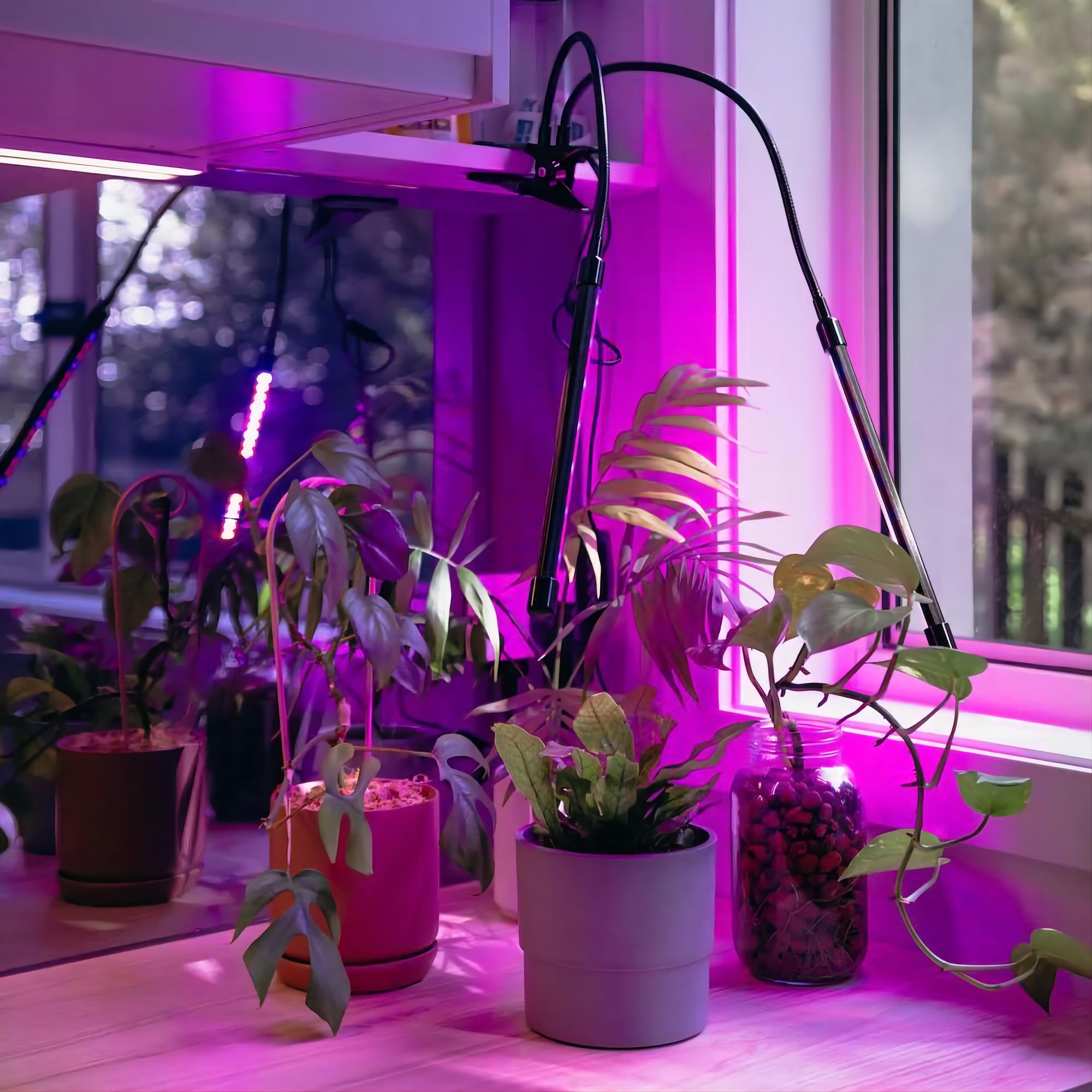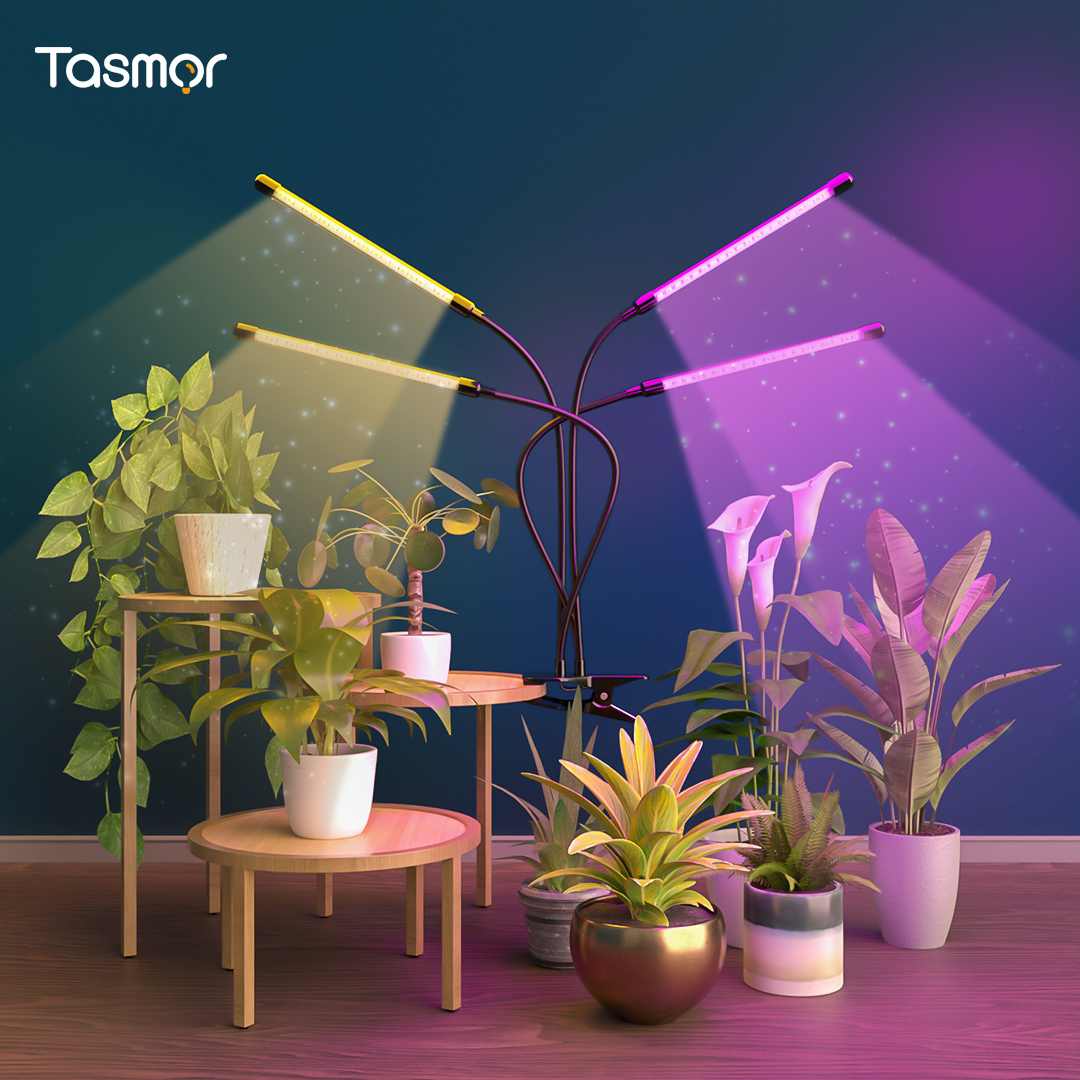Summer is coming to a close and no one is sadder than our plants who have to survive another dry and dark winter. Even hardier plants like spider plants, snake plants, and rubber plants can have a difficult time in winter as even indirect sunlight becomes a rare commodity. Luckily, there’s a solution out there that will not only keep your plants alive, but will help them to prosper all year round: grow lights.
If you are considering getting some grow lights to treat your green friends with, you may have some questions and concerns about grow lights before you make your purchase, so we’ve come up with 7 facts about grow lights that you need to know if you are considering getting some grow lights for your plant pets.
Plants can only achieve photosynthesis by receiving adequate exposure to photons which are particles produced by light. In nature, the sun provides a light spectrum which ultimately dictates the growing cycle of plants throughout the year. You can recreate this process indoors without any access to natural sunlight by using grow lights. Grow lights are one of the best ways to ensure healthy, year-round plant growth, especially if you grow plants which require a high amount of direct sunlight. That said, this all depends on if you choose the right type of grow light for the plants you intend to use them with.
Grow lights work as a substitute for sunlight in that they provide a light spectrum that plants can use to achieve photosynthesis. The efficacy of the grow lights depends on the distance between the light and the plant, the color temperature setting of the grow light, and the type of light bulb used in the grow light. Different lights have different capabilities when it comes to light color and temperature output, so grow lights aren’t a “one size fits all” solution for growing plants. If you are serious about investing in a grow lamp, you need to determine which type of light is best suited to your plants’ needs.
In your research for finding a suitable grow light for your indoor plants, you may have come across the term light color, so what does it have to do with growing plants?
The meaning of grow light color refers to the spectrum of light emitted by the grow light. This spectrum ranges from UV, blue, green, red, to infrared. Plants respond in different ways to the different light colors, for example, UV will make plants grow much faster but is not ideal for the flowering stage. Red light is better for flowering but will slow down the vegetative stage. Having a good grasp on how the light color spectrum affects plants has great advantages when it comes to indoor gardening, check out this article that goes much more into the nitty-gritty of this more sciencey aspect of growing lights.
With the recent and rapid development of grow light technology, these days grow lights give the sun a run for its money. Full spectrum grow lights can’t quite outshine the sun, but they can stimulate almost as much photosynthesis in plants as the sun can. The main advantage sunlight has is that its light is simply more intense in most parts of the world. What a grow light can do for a plant in thirteen hours, the sun can do in six hours.
The biggest advantage grow lights have over sunlight is that they allow you to give light to your plants wherever and whenever you want, so you don’t need to worry about crowding your plants around your south-facing window or your plants dying in winter.

If you have any experience in outdoor gardening, then you might have noticed that some plants can easily get burnt by sunlight on really hot and dry days. Grow light can burn your plants too if the light is placed too close to the canopy of your plants. This is especially the case for high-pressure sodium and metal halide lights because of their intense photon and heat output. LED grow lights are far less likely to burn your plants because of their low heat output and milder light intensity, so they can be placed closer to your plants’ canopy; however, if placed too close to your plants, they can still burn them. Try to keep your LED grow lights at least 6 inches (15cm) above your plants to avoid the risk of burning them.
One of the biggest concerns people have about using grow lights is the impact they’ll have on their electricity bill. This is a totally fair cause for apprehension, considering that you may need to keep your grow light on for up to 12 hours, depending on the kinds of plants you grow. This is one of the main reasons to use LED grow lights. LED grow lights use much less electricity than other types of grow lights and are by far the best option when it comes to energy efficient grow lights.
You can do a very simple calculation to find out how much grow lights will cost you to run LED grow lights by taking the maximum wattage of your grow lights and dividing by one thousand. Then, just multiply that number by the cost per kilowatt hour in your state or province and then multiply by the number of hours you think you’ll use the grow lights on average.
Example calculation for how much it costs to run LED grow lights in Toronto:
Grow Light Wattage = 80W.
80/1000 = 0.08KW.
Fixed Electricity price in Toronto =CAD 8.2 cents per Kilowatt hour
0.08x8.2=CAD 0.66 dollars per hour.
$0.66 x 8 hours= CAD 5.28 dollars per day.
It is important to understand that not all grow lights have UV as UV isn’t necessary for plants to achieve photosynthesis. UV light speeds up the process of photosynthesis, but isn’t necessary. Additionally, one of the main dangers of UV light is that it can be damaging to the skin.
This is one of the understandable concerns regarding health when it comes to using grow lights. If you are concerned about UV radiation, make sure to purchase a grow light that doesn’t have UV. However, when it comes to growing lights that have UV, it shouldn’t be bad for your skin so long as you don’t over expose your skin to direct light from your grow lamp on a regular basis. From a practical standpoint, it is unlikely that you will experience any skin damage from grow lights as grow lights need to remain in a fixed position above the plant itself. It would be far more damaging to your skin if you were to spend the day at the beach on a sunny day than to run grow lights for hundreds of hours.
UV light can be harmful to the cornea, but luckily you shouldn’t have to worry about the light from your grow lights damaging your eyes, unless you stare directly at it for hours in close proximity. After all, the light emitted by grow lamps is only about a third as intense as natural sunlight. The bigger concern by far is making sure you protect your eyes when you go outside on a sunny day. If you are still concerned about any health risks associated with grow lights, you can simply use them on your plants in another room, while you are out and about, or at night time while you are sleeping. That’s the beauty of grow lamps - you can control when and where your plants receive light.

In summary, if you are concerned about your plants’ survival over the winter months, or just want to have more control over when, where and how much light your plants get, you should definitely consider getting grow lights. They make an excellent substitute for natural sunlight and can be run very inexpensively, so long as you go with LED grow lights. When it comes to health concerns and grow lights regarding skin and eyes, just remember that the light emitted by grow lights is much less intense than that of the sun, and if you place your grow lights properly, it shouldn’t have any direct contact with your skin or eyes.
You must be logged in to post a comment.